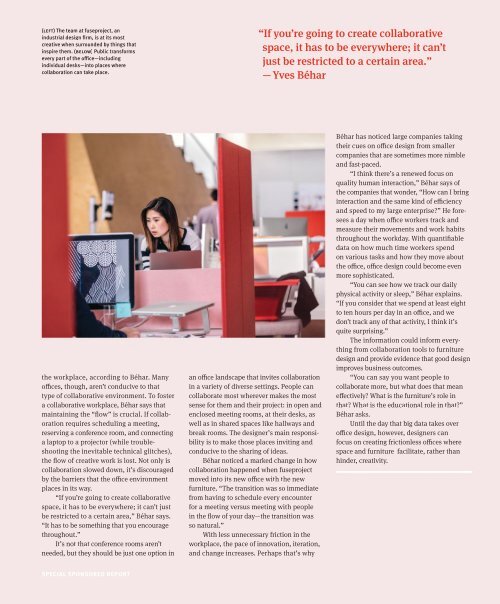Architect 2016-01
You also want an ePaper? Increase the reach of your titles
YUMPU automatically turns print PDFs into web optimized ePapers that Google loves.
(left) The team at fuseproject, an<br />
industrial design firm, is at its most<br />
creative when surrounded by things that<br />
inspire them. (below) Public transforms<br />
every part of the office—including<br />
individual desks—into places where<br />
collaboration can take place.<br />
“If you’re going to create collaborative<br />
space, it has to be everywhere; it can’t<br />
just be restricted to a certain area.”<br />
— Yves Béhar<br />
the workplace, according to Béhar. Many<br />
offices, though, aren’t conducive to that<br />
type of collaborative environment. To foster<br />
a collaborative workplace, Béhar says that<br />
maintaining the “flow” is crucial. If collaboration<br />
requires scheduling a meeting,<br />
reserving a conference room, and connecting<br />
a laptop to a projector (while troubleshooting<br />
the inevitable technical glitches),<br />
the flow of creative work is lost. Not only is<br />
collaboration slowed down, it’s discouraged<br />
by the barriers that the office environment<br />
places in its way.<br />
“If you’re going to create collaborative<br />
space, it has to be everywhere; it can’t just<br />
be restricted to a certain area,” Béhar says.<br />
“It has to be something that you encourage<br />
throughout.”<br />
It’s not that conference rooms aren’t<br />
needed, but they should be just one option in<br />
an office landscape that invites collaboration<br />
in a variety of diverse settings. People can<br />
collaborate most wherever makes the most<br />
sense for them and their project: in open and<br />
enclosed meeting rooms, at their desks, as<br />
well as in shared spaces like hallways and<br />
break rooms. The designer’s main responsibility<br />
is to make those places inviting and<br />
conducive to the sharing of ideas.<br />
Béhar noticed a marked change in how<br />
collaboration happened when fuseproject<br />
moved into its new office with the new<br />
furniture. “The transition was so immediate<br />
from having to schedule every encounter<br />
for a meeting versus meeting with people<br />
in the flow of your day—the transition was<br />
so natural.”<br />
With less unnecessary friction in the<br />
workplace, the pace of innovation, iteration,<br />
and change increases. Perhaps that’s why<br />
Béhar has noticed large companies taking<br />
their cues on office design from smaller<br />
companies that are sometimes more nimble<br />
and fast-paced.<br />
“I think there’s a renewed focus on<br />
quality human interaction,” Béhar says of<br />
the companies that wonder, “How can I bring<br />
interaction and the same kind of efficiency<br />
and speed to my large enterprise?” He foresees<br />
a day when office workers track and<br />
measure their movements and work habits<br />
throughout the workday. With quantifiable<br />
data on how much time workers spend<br />
on various tasks and how they move about<br />
the office, office design could become even<br />
more sophisticated.<br />
“You can see how we track our daily<br />
physical activity or sleep,” Béhar explains.<br />
“If you consider that we spend at least eight<br />
to ten hours per day in an office, and we<br />
don’t track any of that activity, I think it’s<br />
quite surprising.”<br />
The information could inform everything<br />
from collaboration tools to furniture<br />
design and provide evidence that good design<br />
improves business outcomes.<br />
“You can say you want people to<br />
collaborate more, but what does that mean<br />
effectively? What is the furniture’s role in<br />
that? What is the educational role in that?”<br />
Béhar asks.<br />
Until the day that big data takes over<br />
office design, however, designers can<br />
focus on creating frictionless offices where<br />
space and furniture facilitate, rather than<br />
hinder, creativity.<br />
SPECIAL SPONSORED REPORT

















